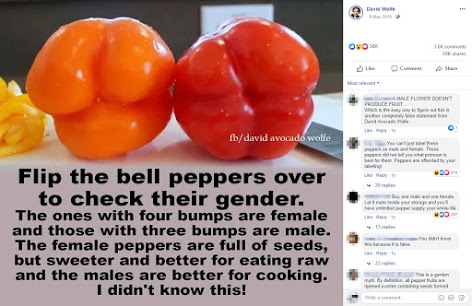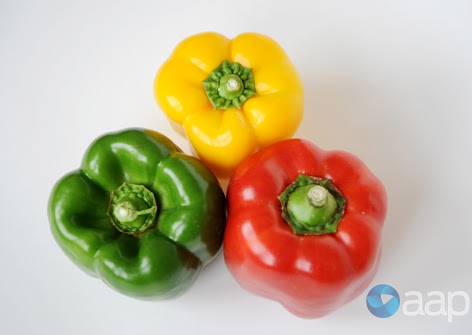The Statement
AAP FactCheck examined a Facebook post by American author and raw food advocate David Wolfe on May 9, 2018 claiming to show a method of identifying the gender of a capsicum – known as a bell pepper in the United States.

The post claims capsicums with four bumps or lobes are female fruit and are sweeter and have more seeds than capsicums with three lobes, which are male. The explanation of how to distinguish between the genders is superimposed on an image showing two capsicums – one with three lobes and one with four.
David Wolfe describes himself in his Facebook profile as “one of the world’s leading orators” and says “his passion is health and wellbeing”.
Mr Wolfe has also filmed infomercials advertising the NutriBullet blender, authored a number of books including ‘Eating for Beauty’, ‘Naked Chocolate’ and ‘Superfoods: The Food and Medicine of the Future’.
He has also spoken publicly against the use of vaccines.
The post has been shared over 59,000 times, and has attracted 38,000 reactions and 3,600 comments.
Mr Wolfe’s Facebook page has over 12.5 million likes.
The image has been shared in Australia as recently as August 5.
The Analysis
Queensland Department of Agriculture, Fisheries and Forestry horticulturist Dr Elio Jovichich told AAP FactCheck, “ Fruits do not have a gender… Any quick search into botany and biology aspects of capsicums will confirm that fruits formed after pollination do not have specific sex.”
Dr Jovichich also said the number of lobes on a capsicum has “no relationship to taste”.
Associate Professor Daniel Tan, from the University of Sydney’s School of Life and Environmental Sciences, told AAP FactCheck the post is “fake news”.
“Each individual capsicum is produced mainly through the self-fertilisation of a flower that is bisexual – both male and female,” Dr Tan said.
“The number of chambers in a capsicum is determined by genetics and has no impact on the number of seeds produced or sweetness of flesh.”
Similar images repeating the capsicum gender claim have been circulating on the internet since at least 2013, and have been debunked multiple times.
Fact-checkers Snopes rebutted the claim in 2015, and a number of gardening or cooking sites, including Culinary Lore and Gardening Know How, have dispelled the myth as well.
Botanist, science writer and BBC broadcaster James Wong also wrote a column in The Guardian contradicting the claim that capsicums have genders, saying: “While there are such things as male and female plants, and even male and female parts of the same flower, there is no such thing as gender (or sex) in fruit. That would imply that fruit sexually reproduce with each other. They don’t.
“They are just a fleshy package that contains the end product of sexual reproduction, the seeds.”
Pat Patterson a horticulture program assistant from Oregon University, also weighed in: “By definition, all pepper fruits are ripened ovaries containing seeds formed after pollination. Those seeds will then form new pepper plants. The bumps or lack thereof are primarily related to the variety and growing conditions. Sweetness is usually a factor of ripeness.”
These experts are supported by the Encyclopedia of Fruit and Nuts, which notes that capsicums come from “perfect” flowers – meaning they have both female and male sex organs: “The flowers are protogynous, but readily self-pollinate.”
The Encyclopaedia also says capsicums have usually between two and four lobes, but can have more.
The Verdict
Based on the advice of experts and the large body of evidence contradicting the claim, AAP FactCheck found the post to be false. Capsicums do not have a singular gender, and the sweetness and number of seeds in the fruit depend on growing conditions, ripeness and varieties, not the number of lobes they have.
False – The Facebook post is false.
* AAP FactCheck is an accredited member of the International Fact-Checking Network. To keep up with our latest fact checks, follow us on Facebook, Twitter and Instagram.
First published August 15, 2019 14:00 AEST


















